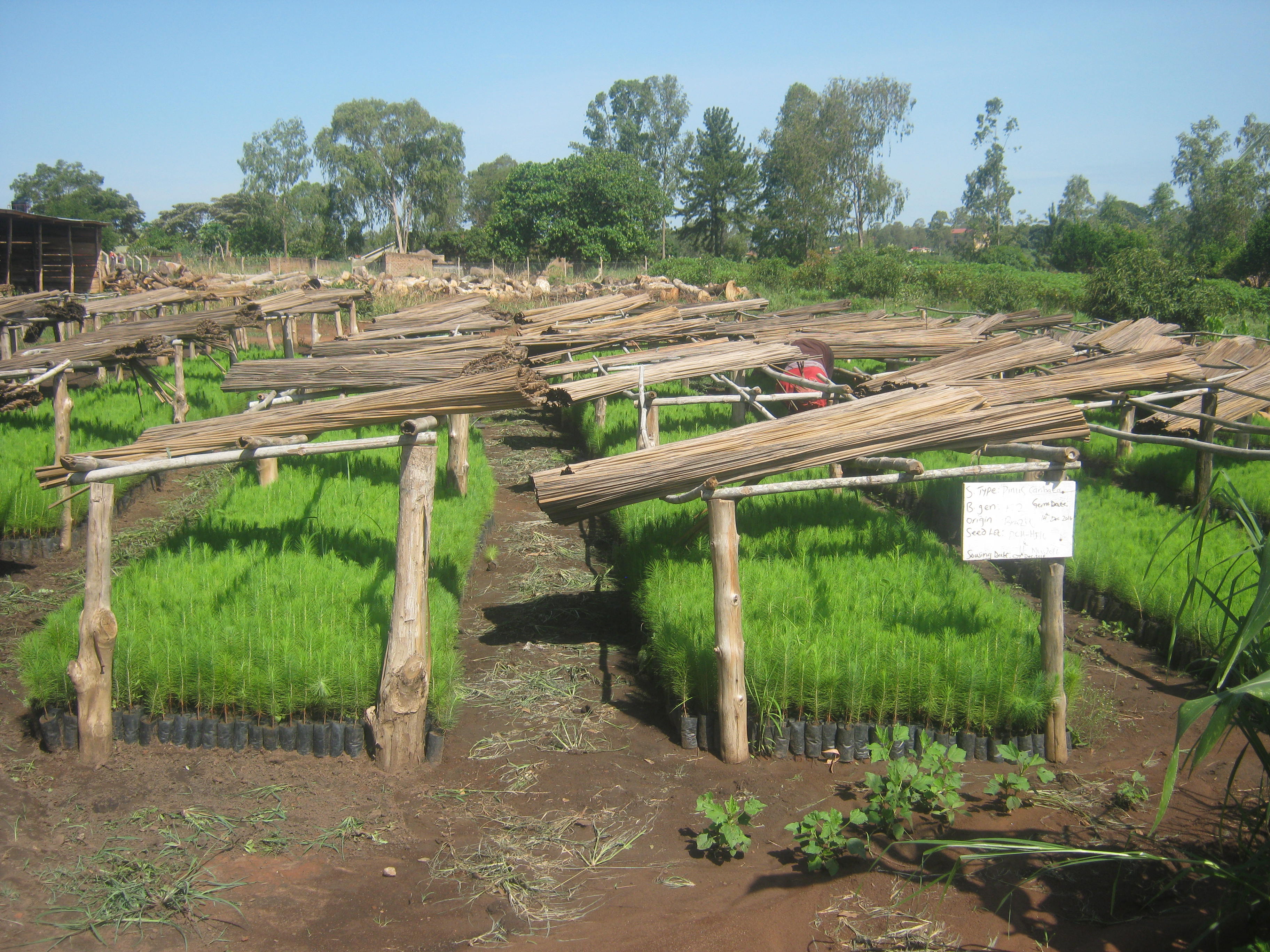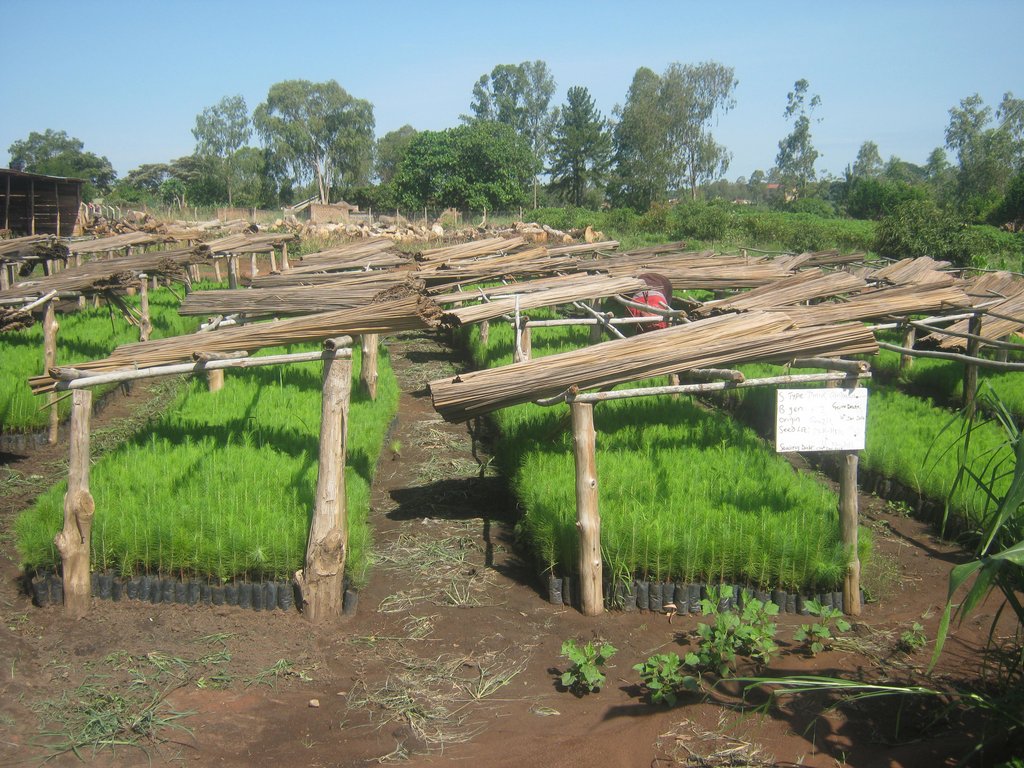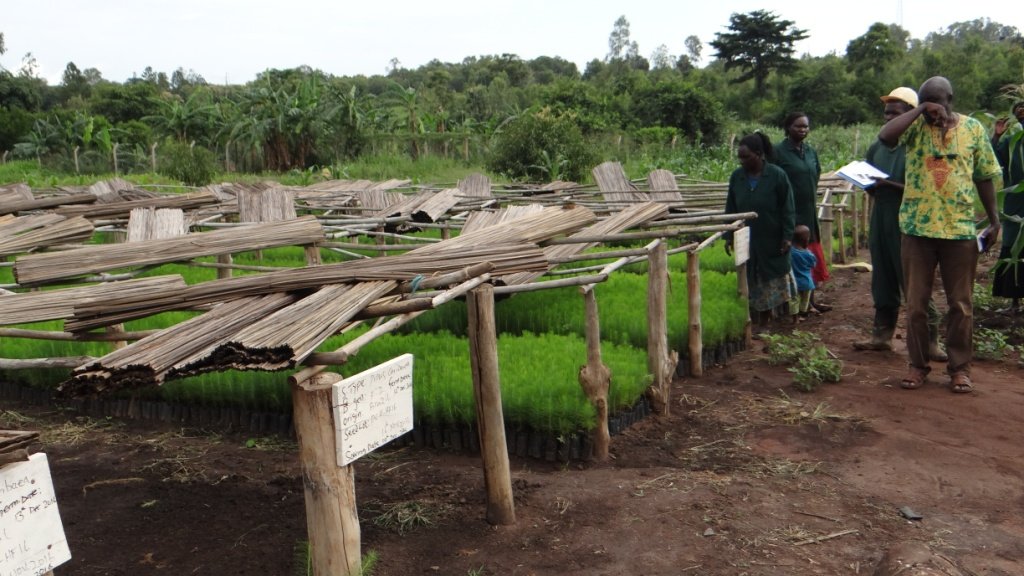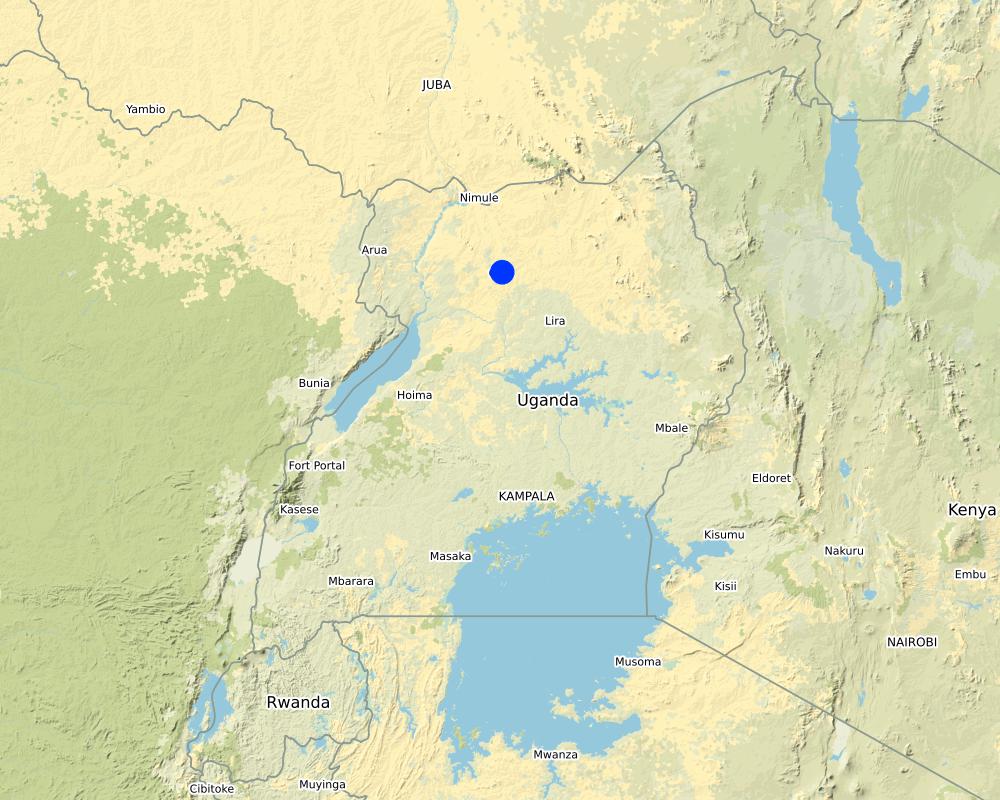Farmer Initiated Pine Tree Planting [Uganda]
- Creation:
- Update:
- Compiler: betty adoch
- Editor: Kamugisha Rick Nelson
- Reviewers: John Stephen Tenywa, Udo Höggel
Tute pa lapur me pito yen
approaches_2898 - Uganda
View sections
Expand all Collapse all1. General information
1.2 Contact details of resource persons and institutions involved in the assessment and documentation of the Approach
Key resource person(s)
land user:
Langoya C. Dickson
0772605432 / 0712335432
jcforestryenterprise@gmail.com / langoyacd@yahoo.com
JC forestry enterprise limited
p.o.box 120
Uganda
Name of project which facilitated the documentation/ evaluation of the Approach (if relevant)
Scaling-up SLM practices by smallholder farmers (IFAD)Name of the institution(s) which facilitated the documentation/ evaluation of the Approach (if relevant)
CDE Centre for Development and Environment (CDE Centre for Development and Environment) - Switzerland1.3 Conditions regarding the use of data documented through WOCAT
When were the data compiled (in the field)?
26/05/2017
The compiler and key resource person(s) accept the conditions regarding the use of data documented through WOCAT:
Yes
2. Description of the SLM Approach
2.1 Short description of the Approach
Farmer owned initiated pine tree planting approach is an individual initiative promoted by a farmer with the aim of establishing modern tree nurseries for raising seedlings for other farmers and communal learning
2.2 Detailed description of the Approach
Detailed description of the Approach:
A farmer started the approach locally and later obtained training and approval to operate as certified tree nursery bed operator by the national forestry authority (NFA) to promote quality tree seedlings promotion. Northern Uganda normally experiences devastating fire outbreaks during dry seasons (November-March) which usually destroy vegetation covers. This leaves the land bare resulting in persistent soil erosion, low soil fertility, low production and low incomes. This is the reason to promote tree nurseries as an alternative source of income. The approach promotes environmental conservation through tree planting, triggers saw-log production, sustainable land utilization and increases household income from the sale of tree seedlings.
The nursery bed project was linked to a saw log production scheme Grant (SPGS) by the National Forestry Authority (NFA) who have supported and trained the farmer with grants/money for procuring the tree seeds from countries like Australia, Brazil and South Africa. This individual farmer together with SPGS and partners first developed guidelines (similar to a community’s constitution) informing on how to establish and manage tree nurseries plantations including marketing products for value addition. The guidelines highlight that:
(1) Prospective beneficiaries must be organized individuals operating a tree nursery bed
(2) The nursery bed should be certified resp. approved by the forestry authority (NFA)
(3) Nursery owners must train other community members on tree nursery bed establishment and tree planting
(4) Nursery owners must provide tree seedlings to other community members for purchase
(5) Beneficiaries must be in position to plant tree seedling in own fields which would, in turn, act as a demonstration site
(6) Beneficiaries should have willingness and ability to perform according to the guidelines (https://www.yumpu.com/en/document/view/37755510/spgs-tree-planting-guidelines for-Uganda-all-chapters-low).
Trees seedling procured by interested farmers are planted into the established seedbed at the onset of the rains under the supervision of the nursery bed owner. The community performs plantation planning meetings and training / exchange visits to empower other farmers to mobilize resources for environmental conservation. Up to now, participating farmers have been involved in raising over 350000 tree seedlings for timber and other tree species per year from 2007.
Benefits linked to this approach include the presence of the leadership committee supported by the guidelines/constitution to guide the farmers' activities, farmer-to-farmer learning, demonstration plots, and access to information and decision support on commercial forest plantation establishment.
The sale of products as well as environmental services has enabled the farmers’ community to extend its networks and partnerships beyond SPGS. Farmer communities also supply tree seedlings to churches, schools and other private clients. They do demonstrations and give advice to farmers so that their seedlings survive.
2.3 Photos of the Approach
2.4 Videos of the Approach
Comments, short description:
Pine seedlings ready for tranplanting
Date:
26/05/2017
Location:
Gulu District, Northern Uganda
Name of videographer:
Betty Adoch
2.5 Country/ region/ locations where the Approach has been applied
Country:
Uganda
Region/ State/ Province:
Northern Uganda.
Further specification of location:
Gulu Municipality
Comments:
The GPS point is at the land user pine tree nursery site
Map
×2.6 Dates of initiation and termination of the Approach
Indicate year of initiation:
2007
2.7 Type of Approach
- recent local initiative/ innovative
2.8 Main aims/ objectives of the Approach
To promote environmental conservation through tree planting, improve saw-log production, sustainable land utilisation, and income
2.9 Conditions enabling or hindering implementation of the Technology/ Technologies applied under the Approach
social/ cultural/ religious norms and values
- enabling
Involvement of local leaders like cultural and religious leaders on trees planting issues by the land user
availability/ access to financial resources and services
- enabling
Saw log production grant scheme (SPGS) and the land user is financially stable
institutional setting
- enabling
Support by SPGS grant and National Forestry Authority (NFA) for capacity building
- hindering
Poor enforcement of bylaws on free grazing
collaboration/ coordination of actors
- enabling
Presence of memorandum of understanding and presence of other tree growers
- hindering
Short term period of collaboration
legal framework (land tenure, land and water use rights)
- enabling
Land user has full right over his private land
- hindering
Land wrangles by neighbours
policies
- enabling
Formulated using bottom-up approach
- hindering
Poor enforcement of laws on tree protections
land governance (decision-making, implementation and enforcement)
- enabling
presence of bylaws, guidelines
- hindering
Poor enforcement
knowledge about SLM, access to technical support
- enabling
Have had training on SLM
- hindering
Low adoption outside SPGS supported farmers
markets (to purchase inputs, sell products) and prices
- enabling
Increased demand for tree products (timber)
- hindering
Sale of raw products at low price
workload, availability of manpower
- enabling
Trained by SPGS and other collaborators
- hindering
Low number of hired labour not trained by SPGS
3. Participation and roles of stakeholders involved
3.1 Stakeholders involved in the Approach and their roles
- local land users/ local communities
Local communities
Implementation and use of approach
- SLM specialists/ agricultural advisers
Small Production Grants Scheme (SPGS),National Forestry Authority (NFA),Uganda Tree Grower Association
Research
- researchers
National Forestry Authority students
Field work and data collection for
publication
- teachers/ school children/ students
University students, primary and secondary
teachers.
Field work and support trainings
- NGO
Food and Agriculture Organisation (FAO),
Uganda Timber Growers Association (UTGA)
Support trainings
- local government
Councillors and Forestry officers
Linkage to NGO's, training's and
administrative guidance as well as security
- national government (planners, decision-makers)
National Forestry Authority (NFA)
Planning and Commissioning
- international organization
Food Agriculture Organisation (FAO)
Funding
3.2 Involvement of local land users/ local communities in the different phases of the Approach
| Involvement of local land users/ local communities | Specify who was involved and describe activities | |
|---|---|---|
| initiation/ motivation | self-mobilization | The land users mobilise resources for the establishment of the tree nursery bed |
| planning | self-mobilization | The land users are active in the planning process of the nursery bed activities |
| implementation | interactive | The land users and SPGS |
| monitoring/ evaluation | interactive | The land users and SPGS |
3.4 Decision-making on the selection of SLM Technology/ Technologies
Specify who decided on the selection of the Technology/ Technologies to be implemented:
- land users alone (self-initiative)
Specify on what basis decisions were made:
- personal experience and opinions (undocumented)
4. Technical support, capacity building, and knowledge management
4.1 Capacity building/ training
Was training provided to land users/ other stakeholders?
Yes
Specify who was trained:
- land users
Form of training:
- on-the-job
- farmer-to-farmer
- demonstration areas
- public meetings
- courses
4.2 Advisory service
Do land users have access to an advisory service?
Yes
Specify whether advisory service is provided:
- on land users' fields
4.3 Institution strengthening (organizational development)
Have institutions been established or strengthened through the Approach?
- yes, greatly
Specify the level(s) at which institutions have been strengthened or established:
- local
- regional
- national
- international
Describe institution, roles and responsibilities, members, etc.
European journalists makes follow up on the project progress basing on the grant given.
Specify type of support:
- financial
- capacity building/ training
- equipment
4.4 Monitoring and evaluation
Is monitoring and evaluation part of the Approach?
Yes
If yes, is this documentation intended to be used for monitoring and evaluation?
Yes
4.5 Research
Was research part of the Approach?
Yes
Specify topics:
- sociology
- economics / marketing
- technology
Give further details and indicate who did the research:
SPGS and university students
5. Financing and external material support
5.1 Annual budget for the SLM component of the Approach
If precise annual budget is not known, indicate range:
- < 2,000
5.2 Financial/ material support provided to land users
Did land users receive financial/ material support for implementing the Technology/ Technologies?
Yes
If yes, specify type(s) of support, conditions, and provider(s):
FAO, SPGS
5.4 Credit
Was credit provided under the Approach for SLM activities?
Yes
Specify conditions (interest rate, payback, etc.):
Interest free loan
Specify credit providers:
SPGS
Specify credit receivers:
The land user
5.5 Other incentives or instruments
Were other incentives or instruments used to promote implementation of SLM Technologies?
Yes
If yes, specify:
Formulation and implementation of bylaws, Trainings, Exchange visits.
6. Impact analysis and concluding statements
6.1 Impacts of the Approach
Did the Approach empower local land users, improve stakeholder participation?
- No
- Yes, little
- Yes, moderately
- Yes, greatly
Farmers are able to utilise their land through tree planting
Did the Approach enable evidence-based decision-making?
- No
- Yes, little
- Yes, moderately
- Yes, greatly
Decision on when to plant the tree nurseries
Did the Approach help land users to implement and maintain SLM Technologies?
- No
- Yes, little
- Yes, moderately
- Yes, greatly
Incentives based (in form of trainings and seedlings)
Did the Approach improve coordination and cost-effective implementation of SLM?
- No
- Yes, little
- Yes, moderately
- Yes, greatly
Coordinated by the land user. Strengthened working as a group (hired labour).
Did the Approach mobilize/ improve access to financial resources for SLM implementation?
- No
- Yes, little
- Yes, moderately
- Yes, greatly
Land user can easily borrow interest free loan from the bank
Did the Approach improve knowledge and capacities of land users to implement SLM?
- No
- Yes, little
- Yes, moderately
- Yes, greatly
Access to technologies (seedlings), knowledge on planting, spacing and pruning and thinning
Did the Approach improve knowledge and capacities of other stakeholders?
- No
- Yes, little
- Yes, moderately
- Yes, greatly
Especially farmers involved and partners
Did the Approach build/ strengthen institutions, collaboration between stakeholders?
- No
- Yes, little
- Yes, moderately
- Yes, greatly
Different partners participated and contributed to implementing the approach. Community bylaws and functioning committee.
Did the Approach mitigate conflicts?
- No
- Yes, little
- Yes, moderately
- Yes, greatly
Conflicts between the land user and livestock owners (Free grazing on trees). Conflicts resolved using bylaws.
Did the Approach empower socially and economically disadvantaged groups?
- No
- Yes, little
- Yes, moderately
- Yes, greatly
Focus was not on well off women farmers but those who had interest in tree planting as an individual or group
Did the Approach improve gender equality and empower women and girls?
- No
- Yes, little
- Yes, moderately
- Yes, greatly
Women are the majority who buy seedlings, eldery and youths
Did the Approach encourage young people/ the next generation of land users to engage in SLM?
- No
- Yes, little
- Yes, moderately
- Yes, greatly
Those who belong to the households from which members came from to buy tree seedlings
Did the Approach improve issues of land tenure/ user rights that hindered implementation of SLM Technologies?
- No
- Yes, little
- Yes, moderately
- Yes, greatly
Focused more on training and production
Did the Approach lead to improved food security/ improved nutrition?
- No
- Yes, little
- Yes, moderately
- Yes, greatly
Income from the sale of tree products was used for buying food
Did the Approach improve access to markets?
- No
- Yes, little
- Yes, moderately
- Yes, greatly
Good quality tree products. Linkage done by SPGS.
Did the Approach lead to improved access to water and sanitation?
- No
- Yes, little
- Yes, moderately
- Yes, greatly
Nursery bed based near the a stream for easy watering
Did the Approach lead to more sustainable use/ sources of energy?
- No
- Yes, little
- Yes, moderately
- Yes, greatly
Source of fuel wood
Did the Approach improve the capacity of the land users to adapt to climate changes/ extremes and mitigate climate related disasters?
- No
- Yes, little
- Yes, moderately
- Yes, greatly
Carbon sequestration
Did the Approach lead to employment, income opportunities?
- No
- Yes, little
- Yes, moderately
- Yes, greatly
Farm workers in the tree nursery bed and plantations
6.2 Main motivation of land users to implement SLM
- increased production
- increased profit(ability), improved cost-benefit-ratio
- reduced land degradation
- reduced risk of disasters
- reduced workload
- rules and regulations (fines)/ enforcement
- prestige, social pressure/ social cohesion
- customs and beliefs, morals
- enhanced SLM knowledge and skills
- aesthetic improvement
- conflict mitigation
6.3 Sustainability of Approach activities
Can the land users sustain what has been implemented through the Approach (without external support)?
- yes
If yes, describe how:
The land user is involved in selling tree seedlings, trees and the income obtained is used to manage the nursery bed and forest activities like fireline, weeding etc. The presence of an organised leadership. With better management skills to manage, the land user will keep working very closely with other groups .
6.4 Strengths/ advantages of the Approach
| Strengths/ advantages/ opportunities in the land user’s view |
|---|
| Maximum productivity per unit area |
| High income |
| Carbon sink |
| Strengths/ advantages/ opportunities in the compiler’s or other key resource person’s view |
|---|
| Modify climate |
| Mitigate land conflict |
| Social interactions |
6.5 Weaknesses/ disadvantages of the Approach and ways of overcoming them
| Weaknesses/ disadvantages/ risks in the land user’s view | How can they be overcome? |
|---|---|
| High cost of planting materials | acquiring own seedling source |
| High costs of inputs and chemicals | purchase affordable once |
| Climate variability | irrigations |
| Weaknesses/ disadvantages/ risks in the compiler’s or other key resource person’s view | How can they be overcome? |
|---|---|
| The approach usually starts by an individual farmer | He needs to form an organisation where they can work as a group for improved efficiency |
7. References and links
7.1 Methods/ sources of information
- field visits, field surveys
01
- interviews with land users
04
Links and modules
Expand all Collapse allLinks
No links
Modules
No modules





